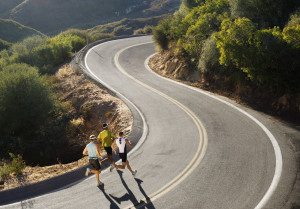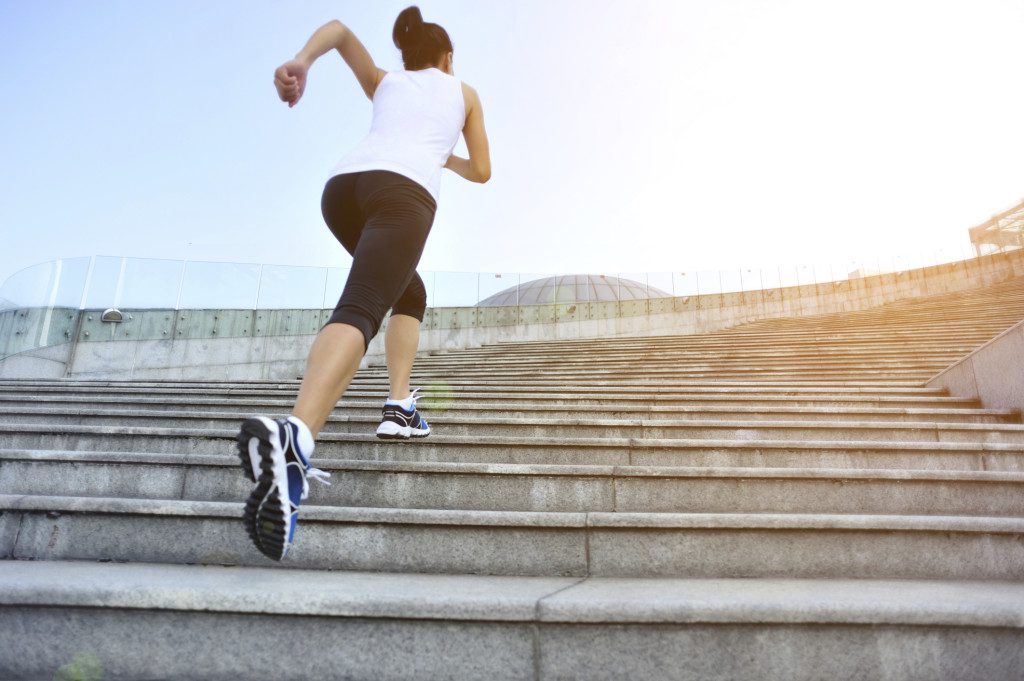Running hills and stairs

— By Jasper Blake
The winter months present a fantastic opportunity for runners to work against gravity and build strength in a simple, free and effective way that also improves technique. Working against gravity creates resistance which increases workload. If you’re looking for a high-intensity workout, a hill or a longer flight of stairs will get you up to a high-intensity effort quickly. With the constant resistance that gravity provides it’s easy to stay at a higher intensity throughout the interval.
From a technical perspective, running uphill or up stairs promotes mid- to forefoot landing. It’s almost impossible to heel-strike (land heel first) which can help promote a higher tempo or cadence. Landing mid- to forefoot often means less ground contact time and can be coordinated with a short, compact arm swing, which is also favourable. Finally, running uphill is great for running posture. It’s natural to lean slightly forward.
Running uphill requires more muscular activity in the posterior chain muscles (erector spinae, gluteal group) and so  it strengthens your postural muscles which will improve your running form. Couple this with the need for shorter, more explosive steps and you have the makings of a great sport-specific strength workout. This is particularly true when running up stairs. The muscle activity required is similar to doing plyometrics particularly if the interval length is short and intense. This type of training stimulus will help increase your speed and strength dramatically.
it strengthens your postural muscles which will improve your running form. Couple this with the need for shorter, more explosive steps and you have the makings of a great sport-specific strength workout. This is particularly true when running up stairs. The muscle activity required is similar to doing plyometrics particularly if the interval length is short and intense. This type of training stimulus will help increase your speed and strength dramatically.
Running up is a great way to avoid injuries that result from impact which is one of the leading causes of running-related injuries. No matter how talented a runner you are, running is hard on your body. When you run fast on flat surfaces you dramatically increase the amount of loading on the body thus increasing your risk for an impact-related injury. Running uphill or up stairs generates less impact load than similar intensities on flatter terrain which may help you avoid injury.
Psychologically speaking, running on hilly terrain has incredible benefits. Triathletes spend a lot of time pounding the pavement and racing on flat, hard surfaces. In the late fall and winter months it can be engaging to get out on hillier terrain. Don’t be afraid to incorporate some snowshoeing into your training. Given that snowshoe trails are often located at ski hills there will be no shortage of vertical to conquer.
But, you don’t need to live in a mountain town to get elevation. You can use very short hills and do multiple repetitions or you can find an office building and crush the stairwell on your lunch hour. Going up is a great way to inject some fun into your program and there are countless benefits.
The workouts
Stairs Workout
- Warm-up — 15 min to the base of a set of stairs or an indoor stairwell that allows you to run up for at least 30 sec
- Activation — 5 x (10 sec building effort up stairs, 50 sec easy walk down)
- Main Set — Four rounds of: 30-sec singles (Touch every stair) 1-min rest/walk back to the start
30-second doubles (touch every second stair)
1-min rest/walk back to the start
30 sec triples (touch every third stair – OR – do doubles again if triples are not possible) 1-min rest/walk back to the start - Cool down — 10–15 min easy but pay attention to the little things that stair running exaggerates like mid- to forefoot impact, slight forward lean and a short compact arm swing.
Hill Workout
- Warm-up — 15 min easy to the base of a hill
- Activation — 5 x (10 sec uphill building effort, 50 sec easy walk/jog back to the start)
- Main Set — 20 min continuous running as follows: 1-min uphill strong, consistent effort with easy jog/walk back to the starting point. There is no defined rest interval during this set- just keep running until 20 min is finished. The goal is to reach the same end point or higher on each interval.
- Cool down — 10–15 min of easy but mindful running connecting with the little things that uphill running exaggerates like mid to forefoot impact, slight forward lean and a short compact arm swing.

